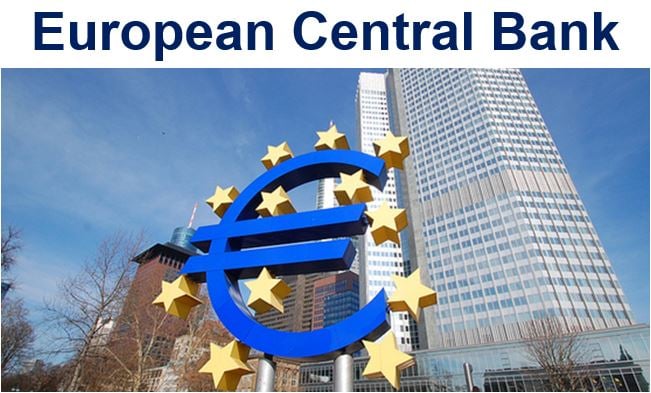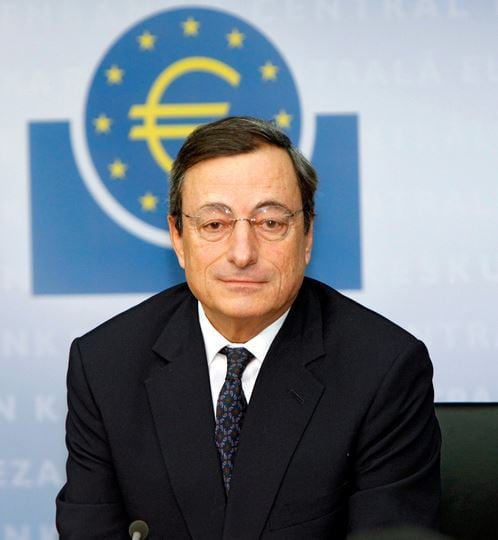The European Central Bank (ECB) is the central banking system for the euro, the single European currency, which replaced the national currencies of 19 of the 28 member states of the European Union.
It is in charge of establishing and managing monetary policy of the eurozone, also known as the euro area. It is one of the biggest currency areas worldwide.
Under Article 16 of its Statute, the ECB has the exclusive right to authorize the issuance of euro banknotes. Eurozone member states do have the right to issue euro coins – the amount has to be authorized by the ECB.

The bank is based in Frankfurt, Germany. The ECB’s owners and shareholders are the central banks of the member states of the EU.
The ECB is one of the world’s most important central banks. It is one of the seven institutions of the European Union (EU) listed in the Treaty on European Union (TEU).
The ECB is owned and operated by member governments of the EU. It focuses on providing loans to support infrastructure, economic development in lesser developed EU poorer regions, meet environmental objectives, among other things.
Economic development, apart of expanding GDP, is also about improving healthcare access, life expectancy, and literacy rates.
European Central Bank decision makers
The ECB has the three-decision making bodies:
The Executive Board – its duties include implementing monetary policy for the eurozone in line with the guidelines and decisions taken by the Governing Council of the European Central Bank.
The Governing Council – formulates monetary policy for the eurozone.
The General Council – deals with transitional issues of euro adoption.

European Central Bank – Tasks
Its basic tasks, as stated by Article 3 of the Statute of the ECB, are to implement monetary policy for the eurozone, conduct foreign exchange operations, manage the foreign reserves of the European System of Central Banks, and operation of the financial market infrastructure.
Article 127(2) of the Treaty on the Functioning of the European Union, also outlines the tasks of the ECB, which include:
- the definition and implementation of monetary policy for the euro area;
- the conduct of foreign exchange operations;
- the holding and management of the official foreign reserves of the euro area countries (portfolio management);
- the promotion of the smooth operation of payment systems.
Other tasks of the ECB include:
- The exclusive right to authorize the issuance of banknotes within the euro area.
- The collection of statistical information necessary in order to meet the tasks of the European System of Central Banks, from national authorities or directly from economic agents.
- Ensuring financial stability and supervision.
- Working and maintaining relations with relevant institutions, both within the EU and at the global level.
In 2003, The Governing Council stated that the ECB’s monetary policies were “in the pursuit of price stability”, adding that “it aims to maintain inflation rates below, but close to, 2% over the medium term.”
The current President of the ECB is Mario Draghi, former governor of the Bank of Italy.
European Central Bank – History
The European Central Bank is the successor of the European Monetary Institute (EMI). The EMI was created during the second stage of the EU’s Economic and Monetary Union (EMU) to prepare for the creation of the ECB and the European System of Central Banks.
The ECB replaced the EMI after the signing of the Treaty on European Union, on 1 June 1998. It wasn’t until the euro came into circulation, in 1999, that the central bank was able to exercise its powers fully.
The ECB President was Wim Duisenberg, former president of the Dutch central bank and the European Monetary Institute.

Started off with eleven members
When it was first created, the ECB only covered a eurozone of eleven member states. Since then, eight other countries have joined.
The following countries belong to the eurozone: Spain, Slovenia, Slovakia, Portugal, the Netherlands, Malta, Luxembourg, Lithuania, Latvia, Italy, Ireland, Greece, Germany, France, Finland, Estonia, Cyprus, Belgium, and Austria.
The 1992 Maastricht Treaty says that EU members must adopt the euro upon meeting certain monetary and budgetary convergence criteria.
However, Denmark and the United Kingdom did not want to join and negotiated exemptions. Sweden turned down the euro in a 2003 referendum.
Video – The European Central Bank
This three-minute explains what the ECB is, as well as the Eurosystem’s role and tasks.
